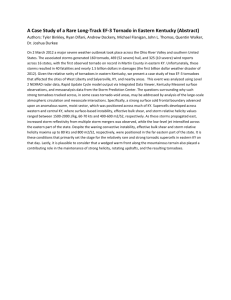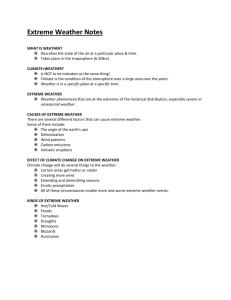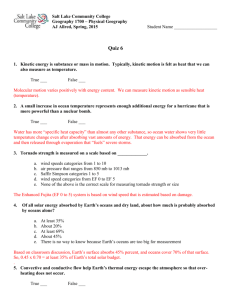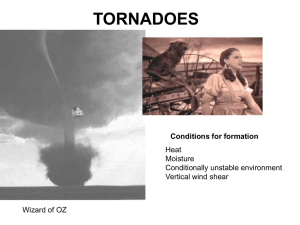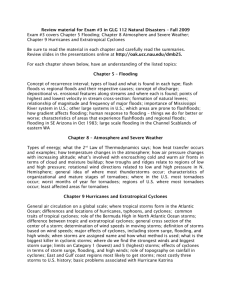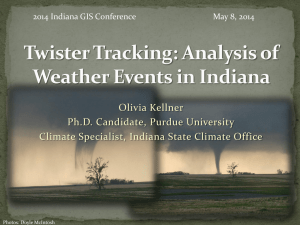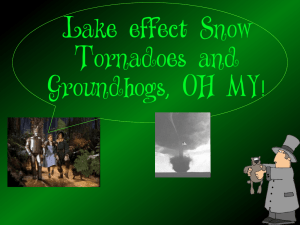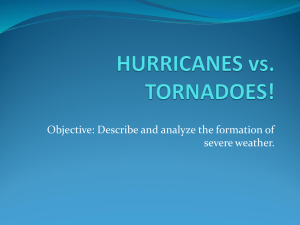Severe Weather and Storm Chasing Presentation
advertisement
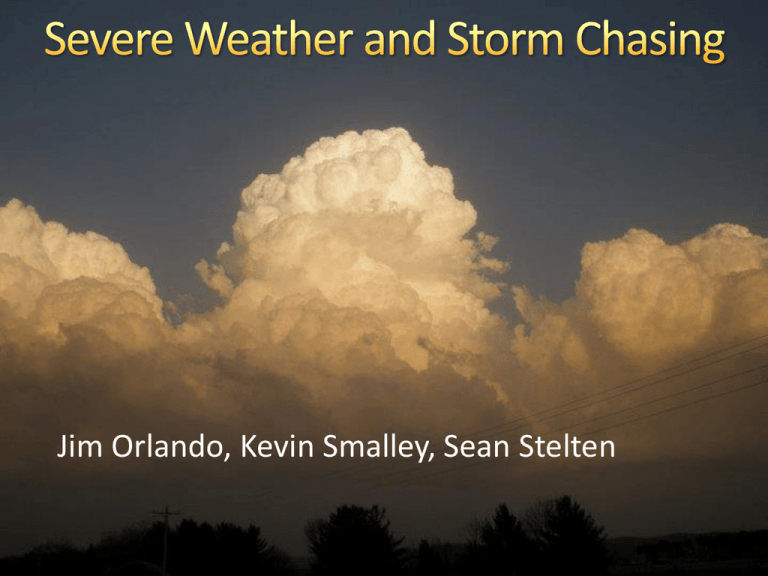
Jim Orlando, Kevin Smalley, Sean Stelten What causes a storm, severe parameters, tools, etc. Thunderstorms need three things to develop: Moisture Instability Some sort of trigger Front, dryline, small scale pressure trough, gravity wave, etc. Severe storms need one more ingredient: Wind shear (both directional and speed) Single cell “Popcorn” storms Usually not severe and fairly short-lived Multi-cell Group of cells moving together Some severe potential Low tornado potential 4 cells Squall lines Now called Quasi-Linear Convective Systems (QCLS) A line of storms Severe potential mainly includes high winds and hail, but there is some tornado potential Supercell Storm with a rotating updraft VERY high severe potential Main tornado producing storm Convective Available Potential Energy The ability that a parcel has to rise Large CAPE usually means large vertical velocities Different types Surface-based Mixed-layer Most unstable 0-3 km “Skinny” and “Fat” CAPE Skinny = weaker updrafts Fat = stronger updrafts “Fat” CAPE CAPE! “Skinny” CAPE CAPE! Thresholds (in J/kg) 1 – 1,000: Marginally unstable 1,000 – 2,500: Moderately unstable 2,500 – 3,500: Very unstable 3,500+: Extremely unstable For 0 – 3 km CAPE, 100+ J/kg is considered a favorable environment for tornadoes Convective Inhibition “Negative CAPE” The result of a “capping inversion”, which can prevent instability from being realized Ways to overcome CIN: Heating (daytime or warm air advection) Added moisture Lift CIN! Thresholds (in J/kg) 0 – 50: Weak cap 50 – 200: Moderate cap 200+: Strong cap These values are negative on most model and mesoanalysis charts Surface-based Mixed-layer Change in wind direction and speed with height, all in one number Most useful values are 0 – 1 km and “Effective” Effective accounts for storm depth (inflow base to equilibrium level) Thresholds 0 – 1 km: 15 – 20+ kts supportive of tornadoes Effective: 25 – 40+ kts supportive of supercells Effective 0–1 km Measure of the potential for a rotating updraft in a supercell Higher numbers are associated with a higher potential for tornadoes Three types: 0 – 1 km, 0 – 3 km, Effective Effective is the most useful in discriminating between tornadic and non-tornadic storms Thresholds (in m2/s2) 0 – 1 km: 100+ 0 – 3 km: 250+ Effective: 100+ 27 April 2011 24 May 2011 You can also get a good idea of helicity by looking at a chart called a hodograph Looping/hook shaped hodographs are indicative of high helicity values Greensburg EF5 Parkersburg EF5 Combination of CAPE and SRH Two types: 0 – 1 km, 0 – 3 km Thresholds >2.5: Favorable for tornadoes Storms must develop in order for this to be useful Can be skewed by high CAPE values LCL Heights Lower heights (<1 km) help with tornado formation, but tornadoes can still form with higher LCLs LCL = 1500m LCL = 750m Lifted Index (LI) Another stability index (taken at 500mb) The lower the number (more negative), the more unstable the atmosphere Supercell Composite Significant Tornado Parameter For these, let’s play a game! Not scary Chen math, unfortunately…… MLCAPE EBS sfc ESRH 2000 MLLCL 250 MLCIN STP * * * * 1500 20 150 1500 200 MUCAPE EBS ESRH SCP * * 1000 20 50 These are best when used to pinpoint a region that severe weather could occur on a given day They should never be used to make any other decisions without actually analyzing the environment Jet Stream Increases shear Separates downdraft from updraft Creates longer-lived storms Low-level Jet (LLJ) Brings in moisture and warmer temperatures Increases shear and helicity Usually kicks in at sunset Upper-level Jet Streaks Increased shear and upward motion Upward motions in right entrance and left exit Left Exit Right Exit Left Entrance Right Entrance Frontal boundaries Cold/warm/stationary fronts, drylines Can enhance shear and helicity Source of lift Surface observations Gives an idea of what’s going on at this moment Look for mesoscale features Satellite imagery Look for clearing early and robust CU fields closer to initiation Water vapor imagery Shows drying and moistening in the mid – upper levels See where fronts/shortwaves are located Moisture Storms won’t form without it Td > 60F best 700mb temps Good indicator of cap strength < 12C in the spring w/o a strong lifting mechanism Can be slightly higher during the summer or with strong lift Theta-E Measure of heat and moisture in the atmosphere Look for theta-e advection/ridges A sign of increased instability and convergence Could be an area of convective development Storm Motion Calculated average direction and speed of stomrs Gives an idea of how storms will move SPC Mesoanalysis Twisterdata COD Analysis AMS Model Animator WPC RAP Weather How to chase safely and effectively South/Southeast of the “hook echo”/storm is the safest place to be Watch for right turning!! Avoid core punching Unless you have a death wish for all of your car windows Avoid rain-wrapped messes Pull off on side roads, not main roads. To see a tornado on your first time out Or second Or third Good chasers usually tend to see a tornado about once every seven chases Don’t let this deter you from chasing, you can’t wind the game if you don’t play! LONG car rides Sitting, waiting, wishing….. Footballs and Frisbees are your friends! Lots of gas station/fast food meals Sketchy dirt roads Few bathroom breaks Awesome tunes The wonder of nature, baby! THE TIME OF YOUR LIFE! AND MEMORIES! Wear REAL shoes or boots Stay away from sandals, especially flip flops Watch the skies, not just the computer Only your eyes can tell you what’s actually happening Try to learn something, not just watch So we’re not held liable if you act stupid. Just kidding. But seriously. CHASE WITH SOMEONE WHO HAS CHASED BEFORE Chase with a partner Stay in the car if there’s lightning nearby Have an escape route Try to head south if you feel that you’re in danger If that’s not possible, head east until you can go south Don’t tempt fate just to get that perfect shot Safety should ALWAYS be your number one concern Give strong/violent tornadoes (especially wedges) their space Keep an eye on the radar AND the tornado Watch out for power poles! Freshmen should NOT go chasing with other freshmen alone Don’t get out of the car if there’s hail Don’t chase at night When stopping, pull ALL the way off the road Don’t pull over on highways Use your flashers Watch out for “those” drivers “Chaser convergence” Avoid “minimum maintenance” roads Previous rainfall could have washed them out Not all of these are marked…. Don’t drive on flooded roads Turn around, don’t drown Don’t drive over power lines/debris Avoid entering debris paths unless absolutely necessary, especially if there are people in your car that don’t have long pants/closed shoes Try to avoid driving through squalls, especially at night Watch out for animals They get spooked and like to run out in front of/into vehicles Watch out for cops They get spooked and like to run out in front of/into vehicles jorlando@iastate.edu ksmalley@iastate.edu sstelten@iastate.edu
